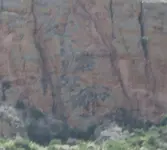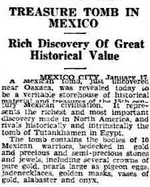gollum said:piegrande said:@airborne: >> 1x 25 ton stone from Stonehenge is average 13 x 7 x 4 feet <times> 2 (for 50 ton stone) = 26 x 14 x 8. 50 tons per stone is roughly 1.1% of 4600 tons. so I multiplied that org. dimensions by 100 and came to 1300 x 700 x 400 or a better estimation would be roughly 1100 x 450 x 300. A solid piece of gold, the size of the USS Nimitz.
Sorry, but if a 25 ton rock is 13 X 7 X 4 feet, then a 50 ton rock is 26 X 7 X 4. 26 X 14 X 8 is 8 times as heavy as 13 X 7 X 4, not twice as heavy. Thus, the latter rock would weight 200 tons, not 50 tons.
I do not know what sort of rocks they have in Stonehenge, but I live in a quarry town here in Mexico. And, the travertine marble here has a specific gravity of around 2.5, which means a cubic foot weighs more or less 150 pounds. So, that weight of the 13 X 7 X 4 feet rock is right on. Good job on that. And, I conclude our rocks weigh about what Stonehenge rocks do. Interesting.
The specific gravity of gold is around 19.3, I believe, which means a cubic foot of gold is around 1200 pounds, not 150 pounds.
I was not smart enough to figure out the US gold production over the last 40 years from the URL you linked, but I can see 4600 tons might be right. So, I am not bothering to figure it out for myself, and am taking your word for that. Gold is usually listed in mt, that is, metric tons, but because I am lazy I am going to use US tons, around 10% lighter to make my life easy, and you did not state differently.
4600 tons X 2000 would be 9,200,000 pounds. A cubic foot of gold weighs around 1,200 pounds, I believe.
9,200,000 / 1200 = 7,626 cubic feet.
My house here in rural Mexico is 2,850 square feet, and the inside walls are 9 feet high. That is 25,650 (editedcubic feet, so 4600 tons of gold would only fill around 30% of my house which is not all that large.
That is, it would be around 32 inches deep if evenly distributed on the floor of my house.
I am sure it would destroy the floors, of course, with that floor supporting 1.6 tons per square feet. (4600 / 2850)
Wiki says Nimitz class carriers have a displacement of 100,000 long tons. I don't think the Nimitz would move very well if you plunked 4,600 tons on it. But, truthfully, I don't know.
I do not intend this as any sort of personal attack, airborne. Just pointing out the correct math.
Piegrande,
I went around the world in 1983 on the USS Carl Vinson CVN-70 (Nimitz Class Carrier). 93,000 Tons and 1097 feet long. a wartime compliment of over 100 aircraft, 6000 crew, and a maximum of about 4 million gallons of fuel (it carries a combination of jet fuel and diesel for other ships in her Carrier Group). The carrier itself needs no fuel as it is powered by two nuclear reactors.
The 100 aircraft alone weigh approximately 1700 tons. 540 tons of people, 7300 tons of diesel, 6500 tons of JP5 (estimating a 50/50 state). That comes out to over 16,000 tons of the basics. That doesn't include fresh water storage, food, tools and equipment, personal items for 6000 people, electronic equipment, bombs, missiles, ammunition, etc, etc, etc.
................ and completely loaded up, it only has a draft of 37 feet. In the worst of seas (North Atlantic and around the Cape of Good Hope), it rides like a 1955 Cadillac down a smooth road. I used to love watching our escort ships play submarine through 70-80 foot waves while we just coasted along. HAHAHA
Mike
Wow, that is a cool posting. Thanks for sharing, and thanks for your service!















